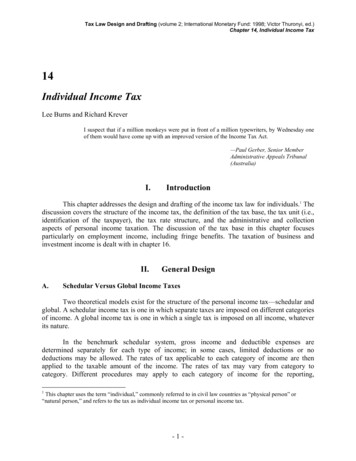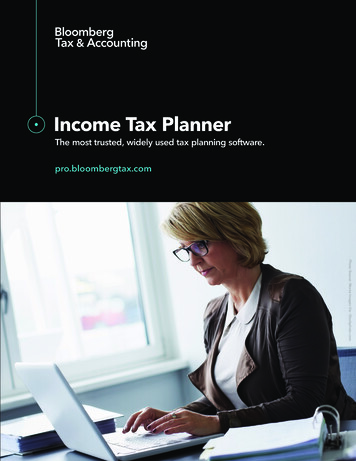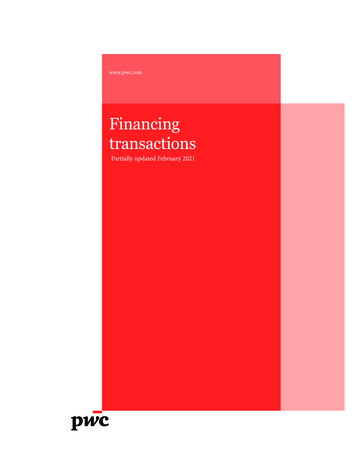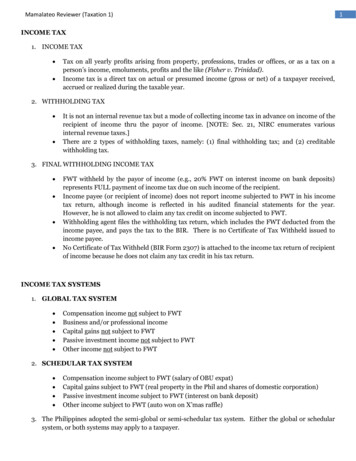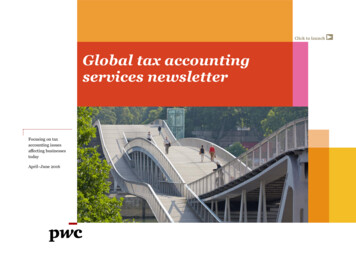
Transcription
Click to launchGlobal tax accountingservices newsletterFocusing on taxaccounting issuesaffecting businessestodayApril–June 2016
Global tax accounting services newsletterIntroductionIn this issueHome SubscriptionAccounting andreporting updatesRecent and upcoming majortax law changesTax accounting refresherContacts and primary authorsIntroductionAndrew WigginsGlobal and UK Tax AccountingServices Leader 44 (0) 121 232 2065andrew.wiggins@uk.pwc.comSenior tax buyers name PwC as their first choiceprovider for tax accounting services globally**These results are based on an independentsurvey of 2,536 primary buyers of taxaccounting services globally, conductedby research agency Jigsaw Research(Q1–Q4 2015).The Global tax accounting services newsletter is aquarterly publication from PwC’s Global TaxAccounting Services (TAS) group. In thenewsletter, we highlight issues that may be ofinterest to tax executives, finance directors, andfinancial controllers.In this issue, we provide an update on regulatoryactivity of the Financial Accounting StandardsBoard (FASB) and the International FinancialReporting Standards (IFRS) InterpretationsCommittee, as well as an update on enforcementactivity of the European Securities and MarketsAuthority (ESMA). We also discuss recent changesto the new revenue standards and restrictions onnon-audit services in the European Union (EU).In addition, we draw your attention to somesignificant tax law and tax rate changes thatoccurred around the globe during the quarterended June 2016.Finally, we discuss some key aspects of income taxaccounting under IFRS and US GAAP for foreigncurrency movements and transactions—one of themore complex areas of accounting for income tax.This newsletter, tax accounting guides, and othertax accounting publications are available online.You can also register and access quarterly TASwebcasts for periodic updates on thelatest developments.If you would like to discuss any of the items in thisnewsletter, tax accounting issues affectingbusinesses today, or general tax accountingmatters, please contact your local PwC team or therelevant Tax Accounting Services network memberlisted at the end of this document.You should not rely on the information containedwithin this newsletter without seeking professionaladvice. For a thorough summary of developments,please consult with your local PwC team.
Global tax accounting services newsletterIntroductionIn this issueHome SubscriptionAccounting andreporting updatesRecent and upcoming majortax law changesTax accounting refresherContacts and primary authorsIn this issueAccounting and reporting updates The FASB activity updateChanges to the new revenue standardsThe IFRS Interpretations Committee activity updateESMA activity updateRestrictions on non-audit services in the EURecent and upcoming major tax law changes Major tax law changesTax accounting refresher Foreign currency tax accountingContacts and primary authors Global and regional tax accounting leadersTax accounting leaders in major countriesPrimary authors
Global tax accounting services newsletterIntroductionIn this issueHome SubscriptionAccounting andreporting updatesRecent and upcoming majortax law changesTax accounting refresherContacts and primary authorsAccounting and reporting updatesThis section offers insight into the most recentdevelopments in accounting standards,financial reporting, and related matters, alongwith the tax accounting implications.The FASB activity updateOverviewDuring the second quarter of 2016, the FASBcontinued its deliberations regarding the followingproposals in the area of accounting forincome taxes: proposal to eliminate the exception torecognising tax effects of intra-entity assettransfers (see the Q4 2015 newsletter formore details) proposal to require detailed disclosures ofgovernment assistance (see the Q4 2015newsletter for more details) proposal to redesign tax disclosures infinancial statementsWe summarise outcomes of the abovedeliberations below.FASB Accounting for Income TaxesProjects placematIn detailIntra-entity assets transfersDuring the first quarter of 2015, the FASB issuedan exposure draft proposing to eliminate thecurrent exception under ASC 740 which defers theincome tax consequences of intra-entity assettransfers when the profits from such transfers areeliminated in consolidation. Following feedbackreceived on the exposure draft and additionalresearch performed by the FASB staff, the FASBtentatively decided the following:1.The exception for all intra-entity transfersother than intra-entity transfers of inventory,will be eliminated.2. The exception for intra-entity transfers ofinventory will be retained.The FASB indicated that the final standard wouldhave an effective date for annual periods beginningafter 15 December 2017 for public companies and15 December 2018 for private companies. Earlyadoption would be permitted.Adoption of the new standard will be effectedthrough a ‘modified retrospective transitionapproach’ (i.e., cumulative catch-up adjustment toopening retained earnings in the period ofadoption). Prior periods would not be (and wouldnot be permitted to be) restated to reflect thechange in accounting.We expect the final Accounting Standard Update(ASU) to be issued later in 2016.Continued
Global tax accounting services newsletterIntroductionIn this issueHome SubscriptionAccounting andreporting updatesDisclosure of government assistanceForeign operationsDuring the fourth quarter of 2015, the FASB issuedan exposure draft requiring detailed disclosures ofgovernment assistance. Depending on the specificfacts in a particular jurisdiction, elements ofgovernment assistance that were subject to therecognition and measurement guidance foraccounting for income taxes (ASC 740), could havebeen subject to the disclosure requirements of theproposed guidance. Following feedback on the exposure draft, duringthe second quarter of 2016 the FASB tentativelydecided to exclude from the scope of the projectgovernment assistance that is subject to ASC 740.The FASB has instead tentatively consideredadditional disclosures as part of the disclosureframework project as noted below.The FASB will continue its deliberations on thisproject at a future meeting. During the second quarter of 2016, the FASBtentatively decided that all entities (both public andprivate) would be required to disclosethe following:income (loss) before income tax expense(benefit) disaggregated between domesticand foreignincome tax expense (benefit) disaggregatedbetween domestic and foreignincome taxes paid disaggregated betweendomestic and foreign. Foreign income taxespaid would be further disaggregated for anycountry that is significant relative to totalincome taxes paid the amount of, and explanation for, a change inassertion about the temporary difference forthe cumulative amount of investmentsassociated with undistributed earnings thatare/or are not asserted to be essentiallypermanent in duration aggregate of cash, cash equivalents, andmarketable securities held byforeign subsidiariesTax disclosuresOver the past two years, the FASB and its staff havebeen deliberating its disclosure framework projectthat included tax disclosures.Recent and upcoming majortax law changesOther terms of any rights or privileges granted by agovernmental entity directly to the reportingentity that have reduced, or may reduce, theentity’s income tax burden in aparticular jurisdictionTax accounting refresher Contacts and primary authorsthat a change in tax law that is probable to havean effect on the entity in a future period hasbeen enactedThe FASB also tentatively decided that publicentities would be required to disclose the following:Uncertain tax positionsThe tabular reconciliation of unrecognised taxbenefits at the beginning and end of the periodwould be enhanced to include: settlements using existing tax assets separatefrom those that are settled in cash a breakdown of the ending balance of theliability for unrecognised tax benefits by theline items in the balance sheet in which thevarious components of the liabilityare recognisedIn addition, the FASB tentatively decided toeliminate the current requirement to disclosepositions for which it is reasonably possible thatthe unrecognised tax benefit will significantlychange within 12 months of the reporting date forall entities.Valuation Allowance an explanation of the nature and amounts ofthe valuation allowance recorded and/orreleased during the reporting periodContinued
Global tax accounting services newsletterIntroductionIn this issueRate Reconciliation Accounting andreporting updates separate disclosure of any individualreconciling item that is more than 5% of theamount computed by multiplying the incomebefore tax by the applicable statutory federalincome tax ratea qualitative description of those items thathave caused a significant movement in the rateyear over yearCarryforwards Home Subscriptionthe gross amounts (i.e., not tax effected) offederal, state, and foreign carryforwards bytime period of expiration for each of the firstfive years after the reporting date and a total ofthe amounts for the remaining years Recent and upcoming majortax law changesthe deferred tax asset for carryforwards (taxeffected), before valuation allowance,disaggregated by federal, state, and foreign.Those amounts should be furtherdisaggregated by time period of expiration foreach of the first five years after the reportingdate and a total of the amounts for theremaining yearsthe total amount of unrecognised tax benefitsthat reduce the tax-effected amountsof carryforwardsThe FASB tentatively decided that non-publicentities would be required to disclose the grossamounts (i.e., not tax effected) of federal, state, andforeign carryforwards.Tax accounting refresherContacts and primary authorsThe FASB tentatively decided to requireprospective transition for all incometax disclosures.The FASB is expected to release an exposure draftlater in 2016.TakeawayThe above developments will likely in some wayaffect virtually all tax-paying entities that apply USGAAP. Organisations should be proactivelyevaluating the implications of the changes beingproposed in these tax accounting areas.Continued
Global tax accounting services newsletterIntroductionIn this issueHome SubscriptionAccounting andreporting updatesRecent and upcoming majortax law changesTax accounting refresherContacts and primary authorsAccounting and reporting updatesThe IFRS Interpretations Committeeactivity updateOverviewDuring the second quarter of 2016, the IFRSInterpretations Committee considered the followingtax-related issues: The presentation of income tax related topayments on financial instruments classifiedas equity The expected manner of recovery of anindefinite-life intangible asset for the purposesof measuring deferred taxWe outline below the Interpretations Committee’sconclusions on these issues.Presentation of income tax related topayments on financial instruments classifiedas equityExpected manner of recovery of anindefinite-life intangible asset for thepurposes of measuring deferred taxThe IFRS Interpretations Committee noted that thecircumstances in which the requirements inparagraph 52B of IAS 12, Income Taxes apply areunclear. Paragraph 52B deals with the presentationof the income tax consequences of dividends incircumstances where different tax rates may apply todistributed and undistributed profits.The Interpretations Committee received a request toclarify the determination of the expected manner ofrecovery of an indefinite-life intangible asset for thepurposes of measuring deferred tax.The IFRS Interpretations Committee decided topropose an amendment to IAS 12 to clarify that thepresentation requirements in paragraph 52B of IAS12 apply to all payments on financial instrumentsclassified as equity that are distributions of profits.The International Accounting Standards Board(IASB) is expected to consider the amendmentproposed by the Interpretations Committee at afuture meeting.The Interpretations Committee noted that whenmeasuring deferred tax on indefinite-life intangibleassets, an entity should apply existing guidance inparagraphs 51 and 51A of IAS 12 and reflect the taxconsequences that would follow from the expectedmanner of recovery of the carrying amount of thoseassets. The Interpretations Committee will discuss ata future meeting if it needs to clarify how todetermine the expected manner of recovery foramortised assets.Continued
Global tax accounting services newsletterIntroductionIn this issueHome SubscriptionAccounting andreporting updatesRecent and upcoming majortax law changesTax accounting refresherContacts and primary authorsAccounting and reporting updatesChanges to the new revenuestandardsKey changesOverviewThe amendments clarify the guidance fordetermining when promises in a contract are‘distinct’ goods or services that should beaccounted for separately. An entity shoulddetermine whether its promise is to transferindividual goods or services to the customer, or acombined item (or items) to which the individualgoods and services are inputs. This guidance isconsistent under US GAAP and IFRS.During the second quarter of 2016, both the FASBand the IASB issued amendments to theirrespective new revenue standards—ASC 606 (USGAAP) and IFRS 15 (IFRS). The amendmentsinclude guidance on identifying performanceobligations, accounting for licences of intellectualproperty (IP) and a number of other changes.As a reminder, the new revenue standards mayhave impact on the cash tax profile of manycompanies or affect computation of book-to-taxdifferences and the related deferred taxes. This isbecause tax law often prescribes special rules forrecognition of revenue for tax purposes.We strongly recommend that companies considerthe tax implications in advance of the effectivedates of the new standards mentioned below, andaddress issues before the standards’implementation.Identifying performance obligationsLicences of IPThe IASB’s amendments to the licensing guidanceclarify when revenue from a licence of IP should berecognised ‘over time’ versus when it should berecognised at a ‘point in time.’The FASB decided to develop a different model,which categorises licences as either ‘functional’ or‘symbolic’ in determining the accountingtreatment. The FASB also provided guidance on theimpact of restrictions in licence agreements,accounting for renewals of licences and the patternof revenue recognition for performance obligationsthat include a licence.These differences between the IASB’s and theFASB’s guidance could result in different outcomesin revenue reported by IFRS reporters and theircompetitors reporting under US GAAP, particularlyin the media, biotech and software industries.The IASB and the FASB also clarified when to applythe guidance on recognising revenue for licences ofIP with fees in the form of a sales- or usage-basedroyalty. These clarifications are consistent underUS GAAP and IFRS.Other changesIn addition to the above amendments, the FASBincluded the guidance on collectibility, non-cashconsideration, presentation of sales tax, andtransition. The FASB also proposed severaltechnical corrections to the new revenuestandard that primarily impact scopingdeterminations and provide additional relief fromcertain disclosure requirements.The IASB’s amendments also includedclarification of the guidance on the principle versusagent assessment (gross versus net revenuepresentation) and additional practical expedientsrelated to transition to the new revenue standard.Continued
Global tax accounting services newsletterIntroductionIn this issueWhy is this important?The amendments do not change the core principlesof the revenue standards but are intended to clarifyapplication of some of the more complex aspects ofthe standard. The amendments could be relevant toa broad range of entities and should be consideredas entities determine the impact of the guidance.Home SubscriptionAccounting andreporting updatesRecent and upcoming majortax law changesMany of the amendments to the standards made bythe IASB and the FASB are not the same. Entitieswith reporting requirements under US GAAP andIFRS will need to consider in their transition processwhether their conclusions could be acceptable underboth frameworks. IFRS reporters with significantcompetitors reporting under US GAAP might needto explain significant differences in application toinvestors.Tax accounting refresherContacts and primary authorsEffective datesThe FASB amendments have the same effective dateand transition requirements as the new revenuestandard, which is effective for calendar year-endpublic companies in 2018 with early adoptionpermitted in 2017. Non-public companies have anadditional year to adopt the new standard.The IASB’s amendments are effective for annualreporting periods beginning on or after 1 January2018, with early application permitted.Continued
Global tax accounting services newsletterIntroductionIn this issueHome SubscriptionAccounting andreporting updatesRecent and upcoming majortax law changesTax accounting refresherContacts and primary authorsAccounting and reporting updatesESMA activity updateOverviewESMA is an independent European UnionAuthority, whose predominant role is to serve asthe European Union’s securities market regulator(similar to the Securities and ExchangeCommission (SEC) in the US). One of ESMA’sareas of responsibility is to promote the effectiveand consistent application of the EuropeanSecurities and Markets legislation with respect tofinancial reporting.On 29 March 2016, ESMA issued its publicReport on Enforcement and RegulatoryActivities of Accounting Enforcers in 2015.The report presented findings of the Europeanaccounting enforcers with respect to ESMA’senforcement priorities for 2014. These werethe topics that ESMA, together with Europeanaccounting enforcers, set as key focus areas of theirexaminations of listed companies’ financialstatements in 2014.The review covered 1,200 issuers, which is close to20% of all IFRS issuers in Europe with securitieslisted on regulated markets. As a result of thereviews, the enforcers took action against 25% ofthe issuers.In detailESMA’s enforcement priorities for 2014 includedrecognition and measurement of deferred taxassets and uncertain tax positions. Key findings inthese areas are summarised below.Deferred tax assetsEuropean enforcers found disclosures related todeferred tax assets arising from unused tax losseswere not adequate in a large number of cases. Thechart below illustrates findings from the reviewswith respect to the disclosure of the support fordeferred tax asset recognition.Chart 1: Disclosure of specific considerationssupporting the deferred tax asset recognitionIn addition, only 27% of the issuers recognisingmaterial deferred tax assets in excess of deferredtax liabilities provided adequate disclosures of theperiod(s) over which deferred tax assets wereexpected to be recovered. The chart belowillustrates the findings from the reviews withrespect to the disclosure of the number of yearsexpected for recovery of the deferred tax assets.Chart 2: Disclosure of number of years expected forrecovery of the deferred tax assetsFurthermore, only half of the issuers reviewed thathad recognised deferred tax assets providedinformation on the significant judgements usedwhen assessing the period expected forrecoverability of the deferred tax assets. In thismatter, most issuers justified the different periodsused by the existence of different time limitsand/or different countries where these tax losseshad originated.Continued
Global tax accounting services newsletterIntroductionIn this issueHome SubscriptionAccounting andreporting updatesRecent and upcoming majortax law changesUncertain tax positionsThe takeawayEuropean enforcers found that 25% of the issuersreviewed had material uncertain tax positions.However, only half of such issuers disclosed theiraccounting policy used for assessing uncertain taxpositions. In addition, only 25% of issuers that hadmaterial uncertain tax positions disclosed theirmeasurement basis.ESMA and the European enforcers haveacknowledged the high standard of application ofIFRS in 2014. However, they also noted room forimprovement, in particular in the application ofIAS 12 requirements related to recognition,measurement, and disclosures of deferred taxassets arising from tax losses. These areas willcontinue to be one of ESMA’s areas of focusin 2016.Tax accounting refresherContacts and primary authorsFor uncertain tax positions, the lack of specificguidance under IFRS seems to have led to diversityin practice. It is expected that this will be rectifiedonce the IFRS Interpretations Committee finalisesits draft Interpretation clarifying the guidance onuncertain tax positions.Continued
Global tax accounting services newsletterIntroductionIn this issueHome SubscriptionAccounting andreporting updatesRecent and upcoming majortax law changesTax accounting refresherContacts and primary authorsAccounting and reporting updatesRestrictions on non-audit services inthe EUOverviewAt the end of 2013 the European Commission,Parliament and Council reached agreement on newlegislation to reform the audit market within theEU. The new legislation includes restrictions onnon-audit services, which apply from the first fiscalyears starting on or after 17 June 2016. Notransitional arrangements or grandfathering isavailable. The restrictions take the form of a cap onthe amount of non-audit fees that can be billed anda ‘blacklist’ of prohibited services that the auditorcannot provide.In addition, the legislation includes rules onmandatory rotation of audit firms for all publicinterest entities in the EU (see the Q1 2014newsletter for more details).In detailThe new legislation restricts the non-audit servicesthat can be provided by the auditor of a publicinterest entity.A public interest entity is defined as any EUdomiciled entity with instruments listed on aregulated EU exchange, any bank or insuranceundertaking. The public interest entity definitionapplies even where a company is part of a grouplisted outside Europe. European subsidiaries of USgroups, for example, will be subject to therestrictions if they have EU-listed securities, an EUbanking licence, or undertake insurance activities.The non-audit services restrictions includethe following: Fees received for non-audit services in any oneyear cannot exceed 70% of the average of theaudit fees billed over the previous three years. There is a list of non-audit services that cannotbe provided by the auditor of a public interestentity (or by its network firms) to that entity, orto its parent or subsidiaries within the EU. Other non-audit services may be provided, aslong as the audit committee of the publicinterest entity approves the provision of theseservices after assessing the potential threats toindependence that could arise, and thesafeguards that have been applied.EU member states have flexibility to implementless onerous or more stringent restrictions relatedto non-audit services in their local law. In addition,the member states have the option to add othernon-audit services to the prohibited list if it isbelieved that the service presents a particularthreat to independence.TakeawayPublic interest entities that use their auditor for theprovision of tax advice and tax compliance servicesshould be mindful of the new restrictions for nonaudit services. This is particularly important as therestrictions apply from the first fiscal years startingon or after 17 June 2016, and there are notransitional arrangements or grandfathering.Public interest entities should also be mindful ofany variations in the restrictions between EUmember states they operate in.Continued
Global tax accounting services newsletterIntroductionIn this issueHome SubscriptionAccounting andreporting updatesRecent and upcoming majortax law changesTax accounting refresherContacts and primary authorsRecent and upcoming major tax law changesThis section focuses on major changes in thetax law that may be of interest to multinationalcompanies and can be helpful in accountingfor income taxes. It is intended to increasereaders’ awareness of the main global tax lawchanges during the quarter, but does not offera comprehensive list of tax law changes thatshould be considered for financial statements.Worldwide tax summariesAustralia Anti-hybrid rules would be introduced andtransfer-pricing rules would be strengthened inline with the Organisation for Economic Cooperation and Development’s (OECD) BaseErosion and Profit Shifting (BEPS) project. Large businesses would be encouraged to adopta tax transparency code. The code represents aset of principles and ‘minimum’ standards forvoluntary disclosure of tax informationby businesses.During the second quarter of 2016, the AustralianTreasurer delivered the 2016-17 Federal Budget,that included the following key proposals: The corporate tax rate would be reduced to25% over ten years. The rate reduction wouldapply to all companies (both resident and nonresident) and to other entities taxed likecompanies/corporations(e.g., limited partnerships). Tax consolidation rules would be modified. Inparticular, adjustments relating to deferred taxliabilities would be removed from entry andexit calculations for entities joining or leavingtax consolidated groups. Penalties for failure to disclose information tothe Australian Taxation Office (ATO) that couldapply to companies with global incomes ofAU 1 billion or more would be increased up toAU 450,000. A 40% ‘diverted profits tax’ (DPT) wouldbe introduced for certain large companies withglobal revenues of AU 1 billion or more. TheDPT is intended to be based on the insufficienteconomic substance aspect of the UnitedKingdom (UK) DPT and would apply inaddition to Australian Multinational AntiAvoidance Legislation (MAAL) which waslargely modelled on the ‘avoided permanentestablishment’ aspect of the UKDPT legislation. The Taxation of Financial Arrangement(TOFA) rules would be simplified. Thisincludes a closer link to accounting, andsimplified accruals and realisation rules, a newtax hedging regime and simplified rules forforeign exchange gains and losses.Continued
Global tax accounting services newsletterIntroductionIn this issueIn addition, the ATO finalised the design of theLocal File requirements under the Australiancountry-by-country (CbC) reporting laws that applyto years beginning on or after 1 January 2016.Taxpayers will need to carefully manage theprocess, especially since there is some divergencefrom the template recommended by the OECD bothin form and content. Failure to comply with theLocal File reporting requirements carries thepossibility of significant penalties up toAU 450,000.CanadaDuring the second quarter of 2016, Canadaimplemented two measures aligned with theOECD’s BEPS project. Effective 1 April 2016, theCanada Revenue Agency (CRA) began sharingselected Canadian tax rulings (e.g., cross-borderrulings related to transfer pricing and preferentialregimes) with certain countries. On 12 May 2016,Canada also joined the Multilateral CompetentAuthority Agreement (MCAA) on the exchange ofcountry-by-country reports. The MCAA has alreadybeen signed by over 35 countries.Home SubscriptionAccounting andreporting updatesRecent and upcoming majortax law changesTax accounting refresherContacts and primary authorsEcuador the amount of profit or loss before taxDuring the second quarter of 2016, the EcuadorianCongress enacted Solidarity Act to fund therebuilding of areas affected by the recentmagnitude 7.8 earthquake. The Solidarity Actincludes a one-time 3% income tax surcharge thatis payable based on taxable income for the 2015 taxyear. The Act also includes a five-year income taxexemption for new productive investments made inthe affected zone. the current year current income tax accrued(excluding deferred tax and uncertaintax positions) the amount of income tax paid in the year the amount of accumulated earningsEUDuring the second quarter of 2016, the EuropeanCommission (EC) presented a proposal for adirective which would require public CbCreporting of tax and other financial data by largecompanies (i.e., companies with consolidatedturnover over EUR 750 million) operating in theEU. The proposed directive would amend theexisting EU Accounting Directive and wouldrequire reporting of the following data: a brief description of the nature of the activities the number of employees the amount of the net turnover, in aggregate,including the turnover with related partiesThe same multinational groups that would have tocomply with the above requirements would also, inprinciple, have to file a country-by-country reportunder OECD BEPS Action 13.In addition, the EU finance ministers have reachedan agreement on the proposed Anti-Tax AvoidanceDirective. The proposed directive includesprovisions dealing with interest deductions,controlled foreign companies, exit taxation, hybridmismatches, and a general anti-abuse rule (see theQ1 2016 newsletter for more details). Aswitchover clause, which was first proposed toensure a minimum effective tax on profits arisingin low or no tax countries, was not included inthe agreement.Continued
Global tax accounting services newsletterIntroductionIn this issueIndiaDuring the second quarter of 2016, thegovernments of India and Mauritius signed aprotocol amending the countries’ taxtreaty. Under the protocol, India will have theright to tax capital gains arising to a resident ofMauritius on the transfer of shares in Indiancompanies acquired on or after 1 April 2017. Inaddition, interest income of a bank resident inMauritius will be taxed in India (with certainexceptions). Lastly, fees for technical servicesarising in India and paid to a resident of Mauritiusmay be taxed in India.Residents of India and Singapore would also
Finally, we discuss some key aspects of income tax accounting under IFRS and US GAAP for foreign currency movements and transactions—one of the more complex areas of accounting for income tax. This newsletter, tax accounting guides, and other tax accounting publications are available . online. You can also register and access quarterly TAS




